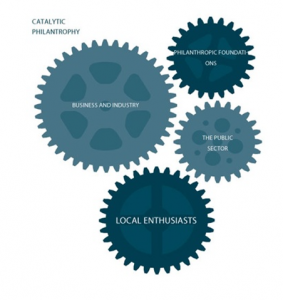
In his blog post, Catalytic Philanthropy: Innovating Where Markets Won’t and Governments Can’t, Bill Gates discusses the idea of catalytic philanthropy, an interesting concept which correlates with a number of topics in business. The practices of catalytic philanthropy goes further than “just writing a cheque”. Gates describes catalytic philanthropy as investing into new innovations and technologies that bring massive returns to people in need or to the society. He describes that catalytic philanthropy lies in a gap between the government and the private sector because governments are in a position such that a justification for bringing innovations into countries outside of their own is very hard to develop and because the returns for the innovator are too low for the private sector to even consider.1
I find that the idea of catalytic philanthropy ties in with corporate social responsibility and creating shared value 2. Gates mentioned in his post, not enough is being accomplished and the potential is far greater than what we have seen.1 As Michael Porter has mentioned in his article, Creating Shared Value, the mainstream practices of corporate social responsibility does not seem to create enough shared value.2 However, innovation is a key component of catalytic philanthropy and that this innovation creates more shared value between companies (or governments or individuals), charities, and the community. I believe that for corporations, creating value should not only be profit driven. Without innovation, the contributions which we make to charities will not be as effective and society as a whole may not receive the maximum benefits from the donation. The innovation that is generated from catalytic philanthropy can potentially create more sustaining value.

I do not think that it is just wealthy individuals and charities who should practice catalytic philanthropy; governments and companies should also integrate the practices of catalytic philanthropy as one of the core values which all of the bodies that encompasses that entity needs to have their activities aligned with. Our current society does not have a system that is effective enough in providing innovative solutions to our greatest issues. The co-operation between different bodies seem too limited to resolve issues on a global scale and in the long run. Catalytic philanthropy seems to be a way of providing better incentives and collaborating resources more effectively towards engineering solutions to deal with our issues.
Word Count: 387
References
1 Gates, Bill. “Catalytic Philanthropy: Innovating Where Markets Won’t and Governments Can’t.” Gatesnotes, 27 Mar. 2014, www.gatesnotes.com/About-Bill-Gates/Catalytic-Philanthropy-Innovating-Where-Markets-Wont. Accessed 12 Nov. 2016.
2 Porter, Michael E., and Mark R. Kramer. “Creating Shared Value.” Harvard Business Review, PDF ed., 2011, pp. 62-77.
Image Source
Catalytic Philanthropy. Gatesnotes, 19 Sept. 2012, www.gatesnotes.com/About-Bill-Gates/The-Power-of-Catalytic-Philanthropy. Accessed 12 Nov. 2016.
“Catalytic Philanthropy.” Realdania, www.realdania.org/nyheder/catalytic-philantrophy. Accessed 12 Nov. 2016.